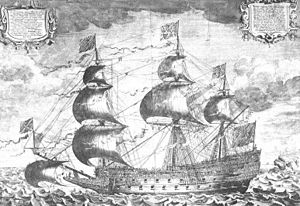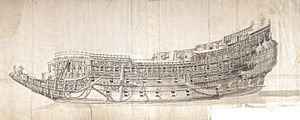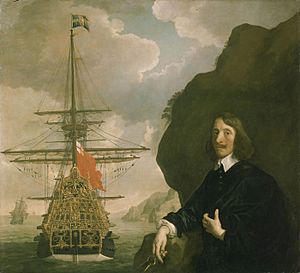HMS Sovereign of the Seas facts for kids

'The true portrait of His Majesty's royal ship the Sovereign of the Seas', a contemporaneous engraving by J. Payne
|
|
Quick facts for kids History |
|
|---|---|
| Name | Sovereign of the Seas |
| Builder | Peter Pett, Woolwich Dockyard |
| Launched | 13 October 1637 |
| Renamed |
|
| Fate | Burnt, 1697 |
| Notes |
|
| General characteristics as built | |
| Class and type | 90-gun first-rate ship of the line |
| Tons burthen | 1522 |
| Length | 127 ft (39 m) (keel) |
| Beam | 46 ft 6 in (14.17 m) |
| Depth of hold | 19 ft 4 in (5.89 m) |
| Propulsion | Sails |
| Sail plan | Full-rigged ship |
| Armament |
|
| General characteristics after 1660 rebuild | |
| Class and type | 100-gun first-rate ship of the line |
| Tons burthen | 1605 |
| Length | 127 ft (39 m) (keel) |
| Beam | 47 ft 6 in (14.48 m) |
| Depth of hold | 19 ft 2 in (5.84 m) |
| Propulsion | Sails |
| Sail plan | Full-rigged ship |
| Armament | 100 guns of various weights of shot |
| General characteristics after 1685 rebuild | |
| Class and type | 100-gun first-rate ship of the line |
| Tons burthen | 1683 tons |
| Length | 167 ft 9 in (51.13 m) (gundeck) |
| Beam | 48 ft 4 in (14.73 m) |
| Depth of hold | 19 ft 4 in (5.89 m) |
| Propulsion | Sails |
| Sail plan | Full-rigged ship |
| Armament | 100 guns of various weights of shot |
The Sovereign of the Seas was a famous warship from the 1600s, part of the English Royal Navy. It was designed to be a powerful 90-gun first-rate ship of the line. However, when it was launched, it had an amazing 102 bronze guns because King Charles I wanted it to be the most powerful ship in the world.
This ship was later renamed HMS Sovereign and then HMS Royal Sovereign. Its stern (the back of the ship) was so decorated with gold that enemies called it the "Golden Devil". The Sovereign of the Seas was launched on October 13, 1637. It served for many years, from 1638 until 1697, when it was accidentally destroyed by fire in Chatham.
Contents
Building the Golden Devil

King Charles I personally ordered the Sovereign of the Seas in 1634. He wanted it to be a grand project that would show off England's power. Some people, like the Brethren of Trinity House, worried that the ship was too big. They said no port in England could hold it safely. They feared it would be lost at sea.
However, with help from Admiral Sir John Pennington, the building began in May 1635. Peter Pett, a skilled shipbuilder, oversaw the work at Woolwich Dockyard. The ship was launched on October 13, 1637. It was only the second ship ever built with three decks, following the Prince Royal from 1610.
The Sovereign of the Seas was the most decorated warship in the Royal Navy. It was covered in gilded (gold-covered) carvings against a black background. These designs were created by Anthony van Dyck. The carvings alone cost £6,691, which was the price of an average warship back then! The total cost of building the ship was £65,586. This money came from a special tax called Ship Money.
Guns and Power
King Charles I wanted the ship to have 102 bronze cannons, making it the most heavily armed ship in the world. These cannons were made by John Browne. The ship had 118 gun ports, but only 102 guns could be used. Some ports were blocked by anchor cables.
The ship carried a massive amount of firepower. For example, on the lower deck, it had twenty large cannon drakes. These were powerful guns that fired heavy shots. The ship's total gun weight was over 155 tons, not including the gun carriages. The guns themselves cost over £26,000. Each gun also had a special engraving of the Tudor rose, a crown, and a Latin motto.
By 1642, the ship's armament was reduced to 90 guns. Until 1655, it was also unusually large compared to other English ships.
A Symbol of Power

The Sovereign of the Seas was not just built for fighting. It was also a symbol to boost the English crown's reputation. Its name itself was a political statement. King Charles I wanted to show that English kings had an ancient right to be seen as the "lords of the seas."
English ships would demand that other ships lower their flags as a salute, even in foreign waters. This was a big deal at the time. The ship's name directly referred to this idea. The carvings on the ship's stern even featured King Edgar, who was believed to be the founder of England's naval strength.
Service and Renaming
After its launch, the ship was modified to make it safer and faster. During the time of the Commonwealth of England, all ships named after royalty were renamed. The Sovereign of the Seas was first going to be called Commonwealth, but in 1650, it was simply named Sovereign.
In 1651, it was made even more agile by reducing some of its upper structures. People described it as "a delicate frigate," meaning it was very impressive. The ship served throughout the wars of the Commonwealth. It became the flagship of General at Sea Robert Blake, a famous admiral.
The Sovereign fought in all the major English naval battles against the United Provinces and France. The Dutch even called it 'The Golden Devil' (den Gulden Duvel).
During the First Anglo-Dutch War in 1652, the Dutch offered a special reward of 3000 guilders to any fireship crew that could destroy the Sovereign. The ship had not seen action during the English Civil War, staying safely docked.
After its 1651 refit, it had its first battle at the Battle of the Kentish Knock, armed with 106 guns. Even though it ran aground during this battle, it remained in service for almost sixty years as one of the best ships in the English fleet. By 1660, its guns were changed to 100.
After the English Restoration, the ship was rebuilt in 1660 at Chatham. It became a 100-gun first-rate ship of the line and was renamed Royal Sovereign. Most of its elaborate carvings were removed during this rebuild.
The Royal Sovereign was involved in the Four Days' Battle and the St. James's Day Battle in 1666, both against the Dutch fleet. It survived the Raid on the Medway in 1667 because it was in Portsmouth at the time.
It underwent a second rebuild in 1685 at Chatham Dockyard, again as a 100-gun first-rate ship. It then took part in the War of the Grand Alliance. The ship sailed into the Irish Sea for the first time. It also fought in the Battle of Beachy Head (1690) and the Battle of La Hougue (1692), even though it was over fifty years old.
The End of the Sovereign
By the reign of King William III, the Sovereign was old and leaky. It was taken to Chatham Dockyards for repairs in late 1695.
Sadly, the ship met an accidental end in mid-January 1696. A bosun (a ship's officer) who was on night watch left a candle burning without supervision. This caused a fire that burned the ship down to the waterline. The bosun admitted his mistake and was punished. He was publicly flogged and imprisoned for the rest of his life.
To honor this famous ship, the name HMS Royal Sovereign has been given to several other ships in the Royal Navy throughout history.
See also
- List of world's largest wooden ships


